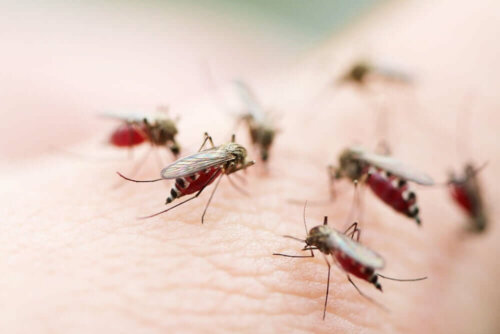Discover 6 Travelers' Diseases


Written and verified by the biologist María Muñoz Navarro
When you travel to other countries, especially tropical ones, you’re at a higher risk of contracting diseases. Therefore, you must take into account preventive measures, such as vaccinations and prior medical advice, to avoid travelers’ diseases.
Most of these diseases are mild, such as diarrhea or respiratory infections, which is why we usually take them lightly. However, when infected travelers return to their countries, they can pose a serious threat to public health due to the risk of local transmission.
Travelers’ diseases
It’s common for people to contract diseases outside their home countries. The only problem with this isn’t that they suffer when they return home, but that they can transmit diseases and make them spread. That’s why medical professionals call them “imported infectious diseases.”
International travel is common nowadays, which is why infectious diseases are the order of the day. The most common are gastrointestinal, respiratory, and dermatological diseases.
Let’s take a look at some of the most common ones.
Traveler’s diarrhea
This is the most common travelers’ disease. Although it’s usually mild, it can be uncomfortable for those who suffer from it throughout their vacation. The most common germs that cause it are:
- Enterotoxigenic Escherichia coli (ETEC). This is the main bacterium that causes this symptomatology. However, coccidian parasites are also becoming increasingly common. Also, viruses such as rotavirus and norovirus, which are included among these pathogens, can also cause it.
- Campylobacter jejuni and E. coli. The main causes of foodborne illnesses. Consuming raw or undercooked meat and poultry increases the risks.
- Salmonella. This is the bacterium that causes typhoid fever, paratyphoid fever, and foodborne illnesses.
- Shigella is another of the pathogenic bacteria that spread by eating contaminated food.
Malaria
Although it’s a disease that experts considered eradicated for years, it still affects many tropical and subtropical countries, which makes it a risk as a travelers’ disease. It causes between 350 and 500 million infections and up to 1 million deaths per year, according to the Global Malaria Action Plan.
Malaria is increasingly being imported into developed countries due to the fact that a lot of people travel to tropical countries. The transmission of the Plasmodium falciparum parasite used to occur among the citizens of the endemic country. However, nowadays, it’s common for people who visit the country to become infected.

Keep reading: The 5 Most Common Insect Bites and How to Treat Them
Travelers’ diseases: Dengue fever
Dengue fever is a disease that the dengue virus, of the Flaviviridae family, causes. In fact, it’s transmitted through the female Aedes mosquitoes. Although experts consider it an endemic disease typical of tropical countries, it expanded worldwide due to globalization and air transport.
This disease can manifest with different severity levels, from a mild fever to dengue hemorrhagic fever.
There is a vaccine. However, the problem with the vaccine is that there are four serotypes of the virus. Thus, this makes it difficult to prepare the immunization.
Zika virus
As in the previous cases, travel contributed to the rapid expansion of Zika, which generated a serious public health problem.
It’s spread by the bite of the Aedes mosquito, similar to the one that transmits dengue fever. When a healthy mosquito bites an infected person or mammal, the virus passes into the mosquito’s blood and, from that moment on, it’ll spread the virus to the rest of the beings it bites.
Sexual contact has also been studied as one of the most common ways of contracting and transmitting the virus. This is because it’s present in the seminal fluid of the infected person. This is very dangerous for pregnant women, as they can have babies with microcephaly.
As it’s a travelers’ disease, an infected person can spread the virus to different regions by traveling. In fact, there are even cases in which infected mosquitoes traveled with the tourist in their luggage.
Travelers’ diseases: Chikungunya
This disease causes severe arthralgia in the infected person, making them hunch over. In addition, its other symptoms resemble those of dengue fever and Zika.
Although dengue fever, also in the Flaviviridae family, can be transmitted from mother to child during pregnancy, like Zika, it can’t be contracted through sexual contact. And chikungunya causes a very high fever and joint pain, which differentiate it from Zika fever.
The tiger mosquito (Aedes albopictus) transmits this travelers’ disease. In fact, it’s diagnosed in many different countries every year, especially in immigrants.
Crimean Congo hemorrhagic fever (CCHF)
So far, we’ve seen examples of insect-borne travelers’ diseases. The generic name of these syndromes is viral hemorrhagic fevers (VHFs). In addition, their symptoms range from asymptomatic infection to fatal cases.
Crimean Congo hemorrhagic fever (CCHF) is a VHF that’s transmitted by tick bites. This infection causes fever and milder bleeding than Ebola, for which there’s no antiviral treatment.
Health personnel are at risk, as they can treat infected patients, in addition to nosocomial transmission. Although it’s common in Africa, as we’ve been commenting in this article, its expansion is associated with the spread of travelers’ diseases.

Find out more here: Can You Eat Food that Has Fallen on the Ground?
Some prevention and education measures for travelers’ diseases
As you’ve seen, you must take certain medical considerations into account before embarking on a trip. Travelers’ diseases are quite concerning nowadays due to the fact that people are traveling more and more every day.
By taking basic measures, we can prevent the contagion and future transmission of these pathogens in our country and to people in our environment. These recommendations include the following:
- First, seek prior medical advice before travel. This is especially important for high-risk people, such as those who suffer from a chronic disease, the elderly, children, and pregnant women.
- Carry printed safety measure instructions for the destination country.
- Review the vaccination schedules of all the family members who are going to travel.
- Follow the behavior and self-treatment strategies. Above all, adopt measures to protect yourself from insects.
- You should especially pay attention to food security and the water you drink.
Although we mentioned some of the most common diseases that you can catch while traveling in this article, you must remember that they aren’t the only ones. For example, the Avian flu, influenza A, SARS, Ebola, and diphtheria, among others.
No matter what the illness, the key is to follow the tips above and get proper medical attention should any symptoms arise.
All cited sources were thoroughly reviewed by our team to ensure their quality, reliability, currency, and validity. The bibliography of this article was considered reliable and of academic or scientific accuracy.
- Freedman, D.O., Chen, L.H. and Kozarsky, P.E. Medical considerations before international travel. N. Engl. J. Med. (2016) 375 (3): 247-260.
- Pavli, A. and Maltezou, H.C. Malaria and travellers visiting friends and relatives. Travel Med. Infect. Dis. (2010) 8 (3): 161-168.
- Ross, A.G.P., Olds, G.R., Cripps, A.W., Farrar, J.J. and McManus, D.P. Enteropathogens and chronic illness in returning travelers. N. Engl. J. Med. (2013) 368(19).
- Noor, R. and Ahmed, T. Zika virus: epidemiological study and its association with public health risk. J. Infect. Public Health. (2018) 11(5): 611-616.
- Weaver, S.C. and Lecuit, M. Chikungunya virus and the global spread of a mosquito-borne disease. N. Eng. J. Med. (2015) 372(13).
- Leblebicioglu, H., Ozaras, R., Fletcher, T.E. and Beeching, N.J. ESCMID study group for infectios in travellers and migrants (ESGITM). Crimean-Congo haemorrhagic fever in travellers: a systematic review. Travel Med. Infect. Dis. (2016) 14(2):73-80.
- Khetarpal, N. and Khanna, I. Dengue fever: causes, complications, and vaccine strategies. Journal of Immunology Research. (2016) 2016:6803098.
- Mischilnger, J., Rönnberg, C, Álvarez-Martínez M.J. et al. Imported malaria in countries where malaria is not endemic: a comparision of semi-immune and nonimmune travelers. Clin. Microbiol. Rev. (2020) 33(2)
This text is provided for informational purposes only and does not replace consultation with a professional. If in doubt, consult your specialist.








